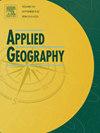The impact of changing ambient population composition on crime during COVID-19 lockdowns
IF 5.4
2区 地球科学
Q1 GEOGRAPHY
引用次数: 0
Abstract
Governments around the world implemented social distancing measures and lockdowns to limit people's movement and stem the spread of the global COVID-19 pandemic. These restrictions have changed the ambient population and altered its racial composition. By analyzing trips between census block groups using data from SafeGraph, we calculate the ambient population and infer its racial makeup during pre-lockdown, lockdown, early-post lockdown, and late-post lockdown periods in Cincinnati, Ohio. We examine the relationship between the ambient population-based racial heterogeneity (H) index and assault, robbery, and theft across the four periods. Our findings indicate that the lockdown affected mobility differently across racial groups. Additionally, we observe a stable, statistically significant influence of the ambient population-based H index on street crimes, in contrast to traditional census-based and spatial lagged measurements. This study demonstrates the effectiveness of the ambient population-based H index in explaining street crimes, particularly when people's routine interactions are significantly altered. It also contributes to theories of social organization, crime mobility, and routine activities.
COVID-19封锁期间环境人口构成变化对犯罪的影响
世界各国政府实施了社交距离措施和封锁,以限制人员流动,遏制全球COVID-19大流行的传播。这些限制改变了周围的人口,改变了其种族构成。通过使用SafeGraph的数据分析人口普查街区之间的出行情况,我们计算了俄亥俄州辛辛那提市封锁前、封锁前、封锁后早期和封锁后后期的环境人口,并推断其种族构成。我们研究了四个时期环境人口种族异质性指数(H)与袭击、抢劫和盗窃之间的关系。我们的研究结果表明,封锁对不同种族群体的流动性影响不同。此外,与传统的基于人口普查和空间滞后的测量方法相比,我们观察到基于环境人口的H指数对街头犯罪的稳定、统计显著影响。这项研究证明了基于环境人口的H指数在解释街头犯罪方面的有效性,特别是当人们的日常互动发生重大变化时。它还有助于社会组织、犯罪流动和日常活动的理论。
本文章由计算机程序翻译,如有差异,请以英文原文为准。
求助全文
约1分钟内获得全文
求助全文
来源期刊

Applied Geography
GEOGRAPHY-
CiteScore
8.00
自引率
2.00%
发文量
134
期刊介绍:
Applied Geography is a journal devoted to the publication of research which utilizes geographic approaches (human, physical, nature-society and GIScience) to resolve human problems that have a spatial dimension. These problems may be related to the assessment, management and allocation of the world physical and/or human resources. The underlying rationale of the journal is that only through a clear understanding of the relevant societal, physical, and coupled natural-humans systems can we resolve such problems. Papers are invited on any theme involving the application of geographical theory and methodology in the resolution of human problems.
 求助内容:
求助内容: 应助结果提醒方式:
应助结果提醒方式:


